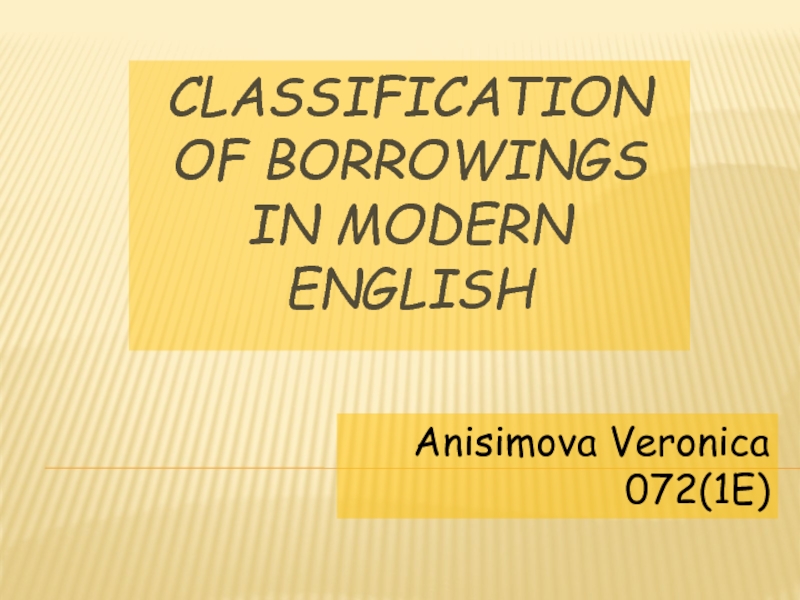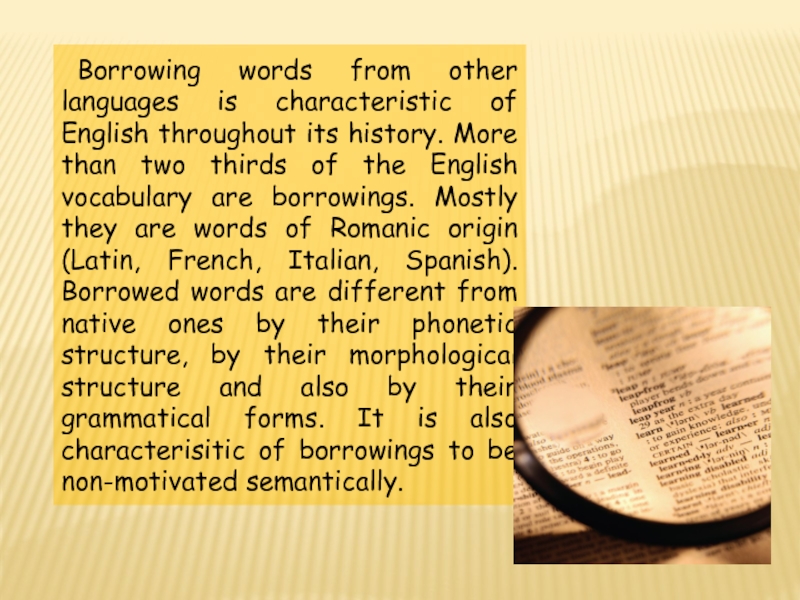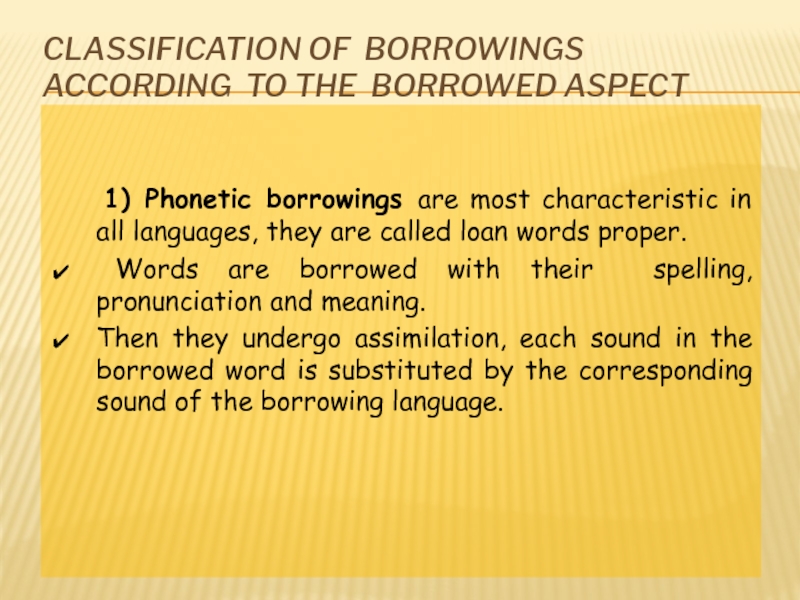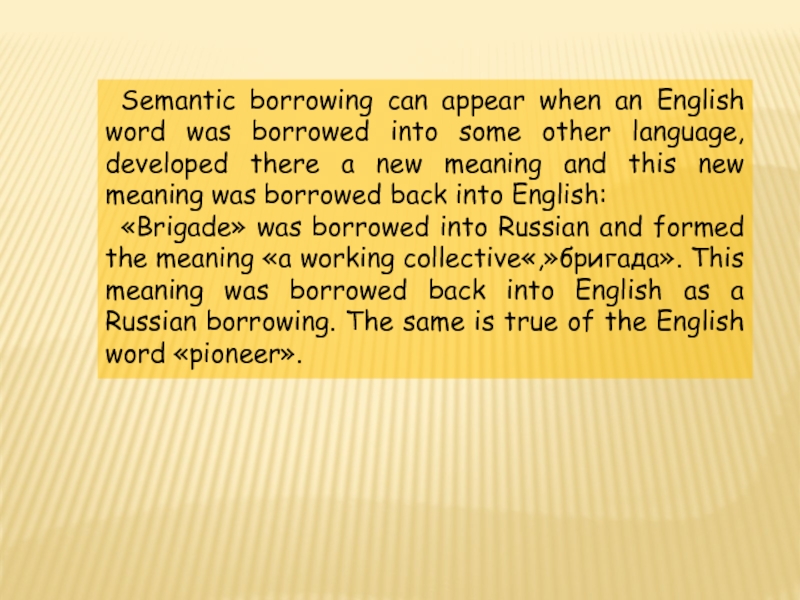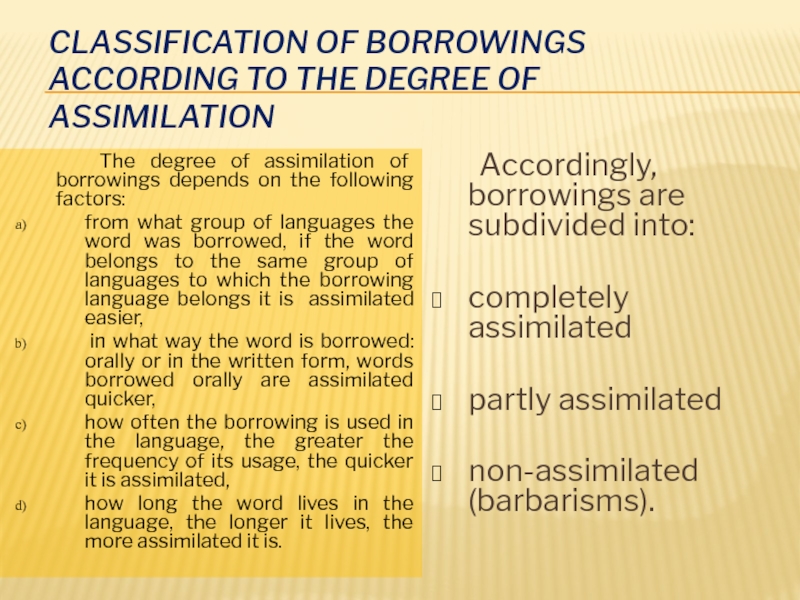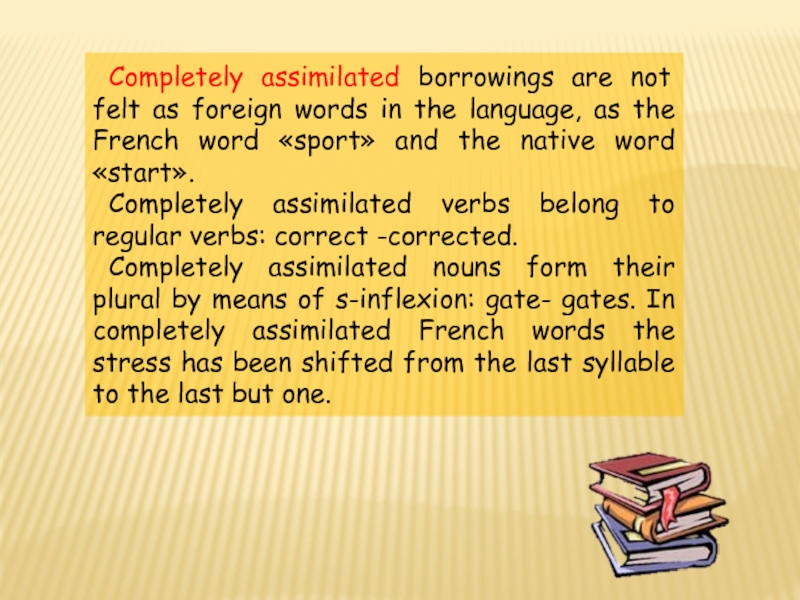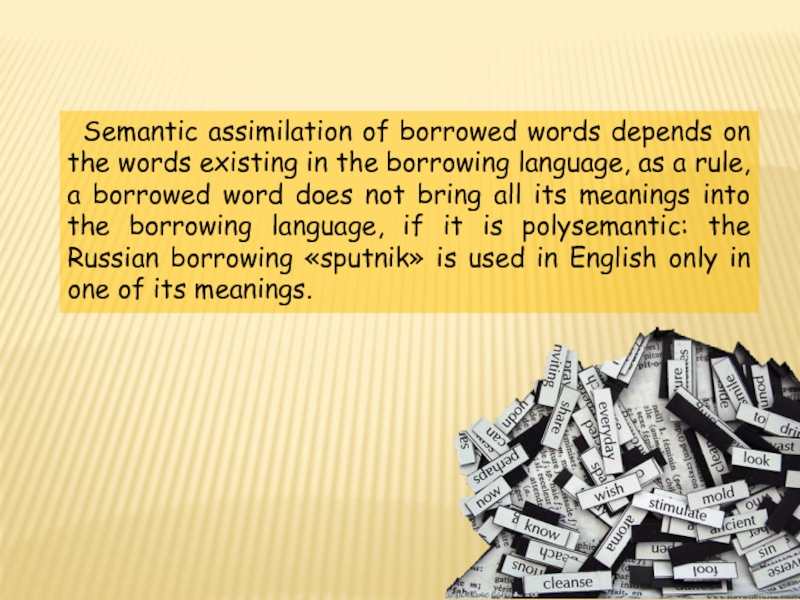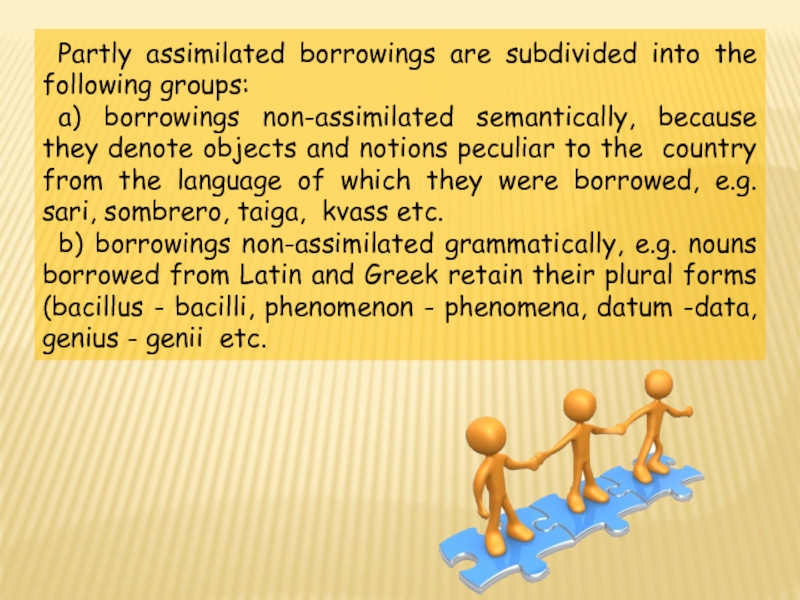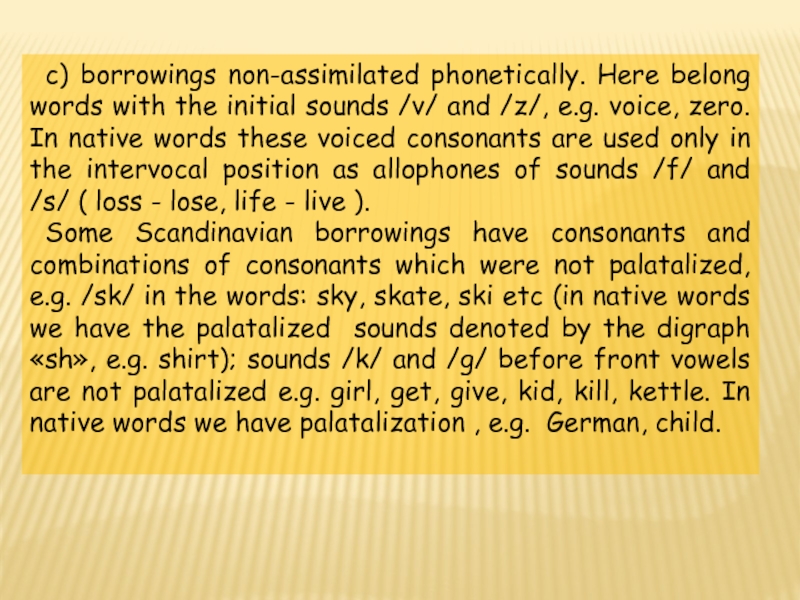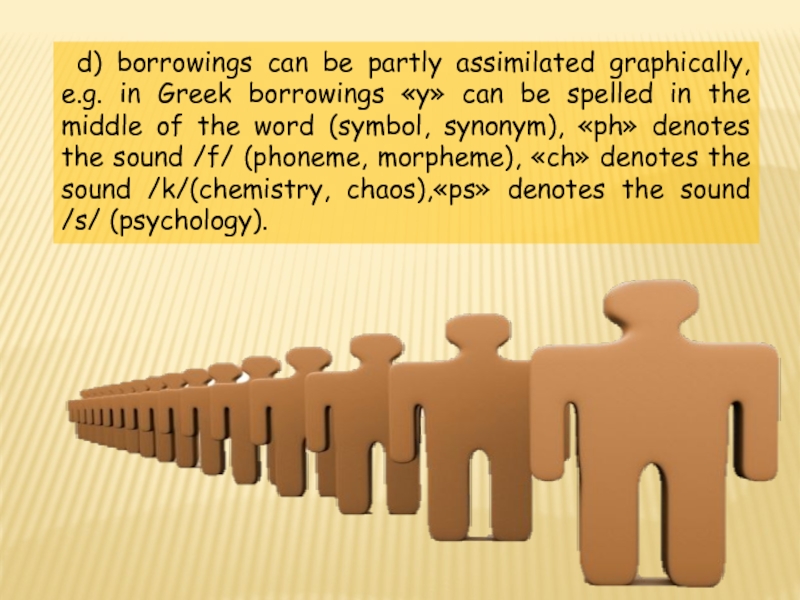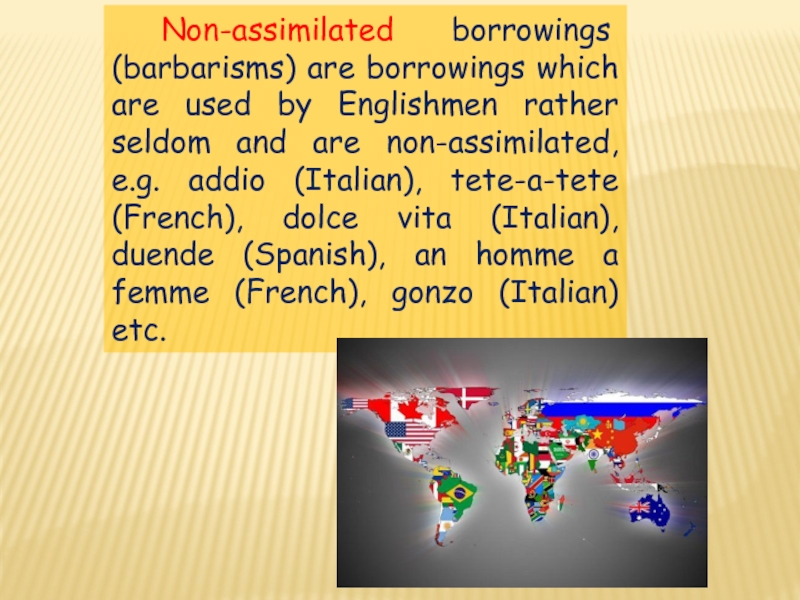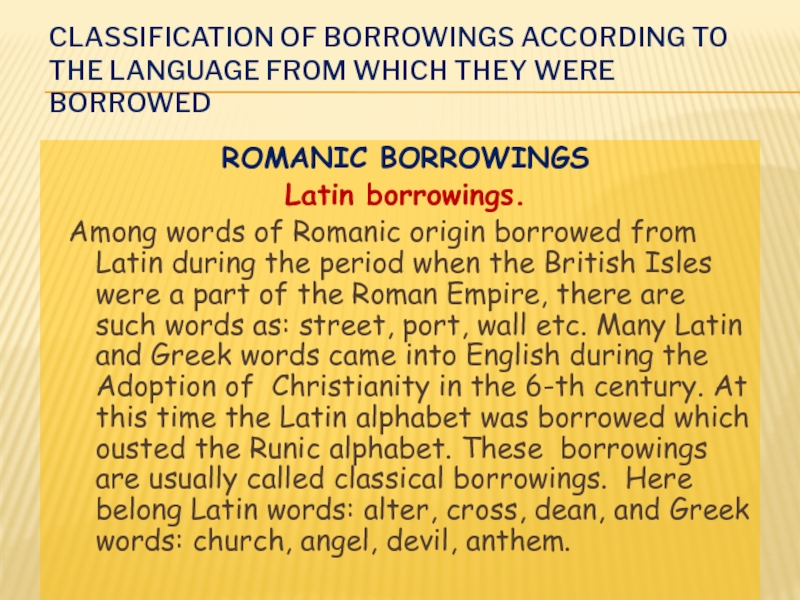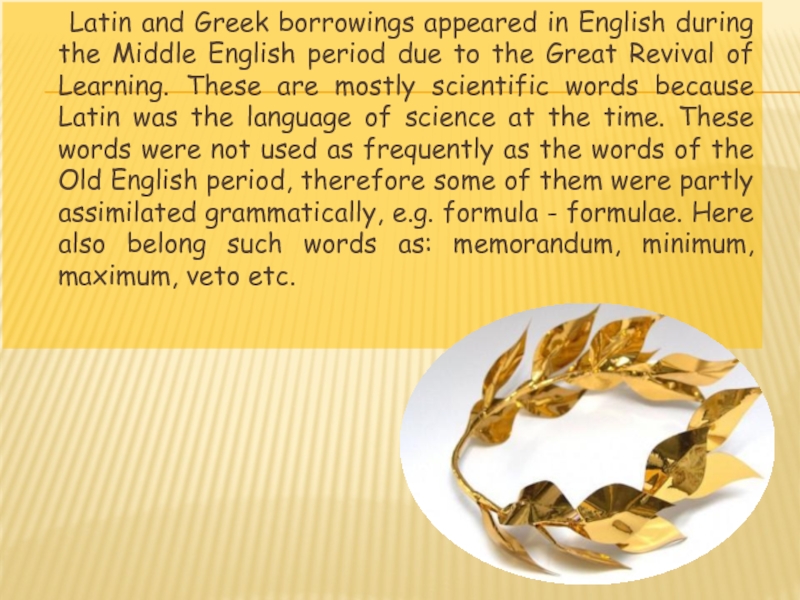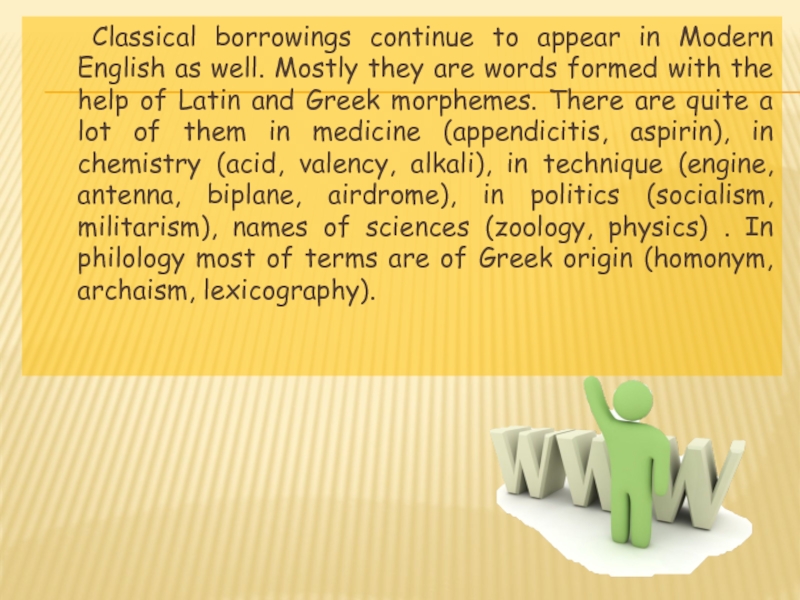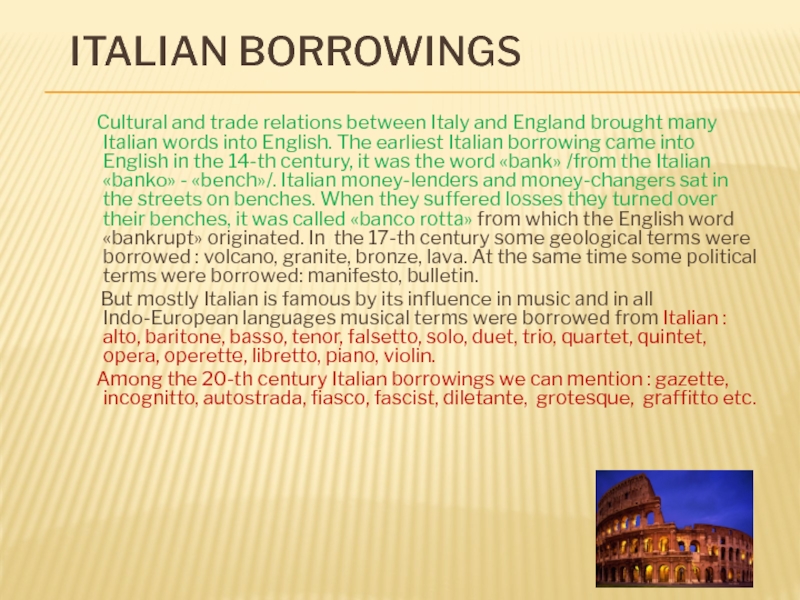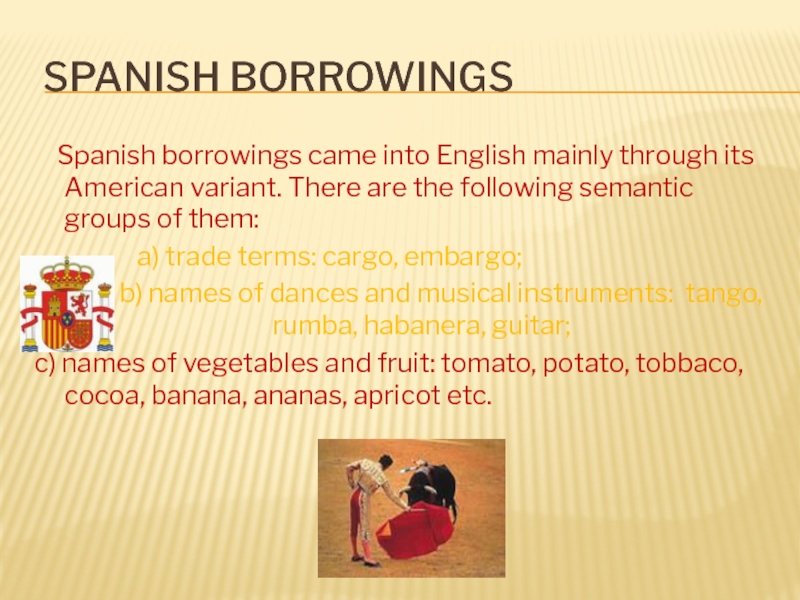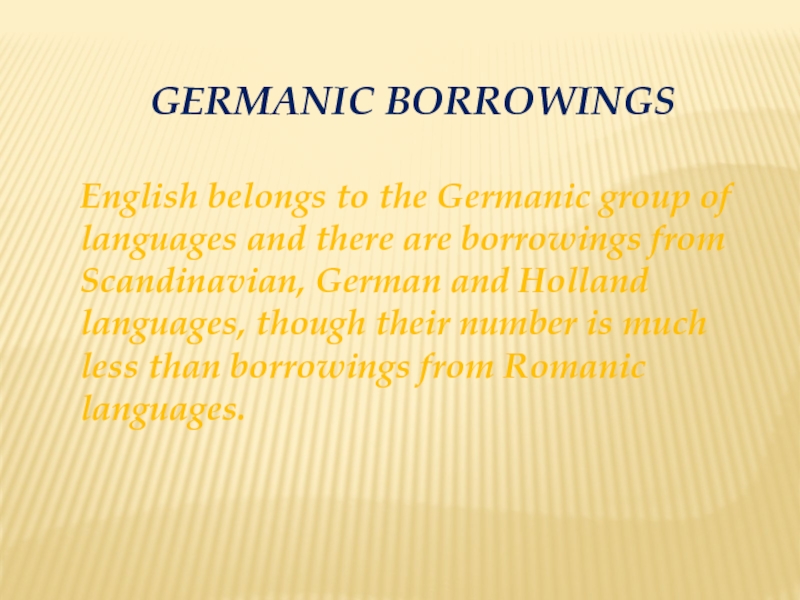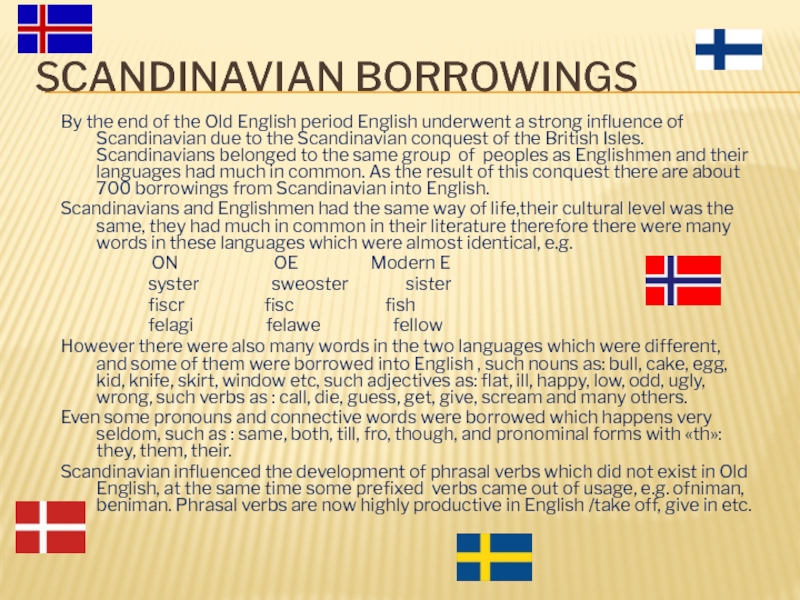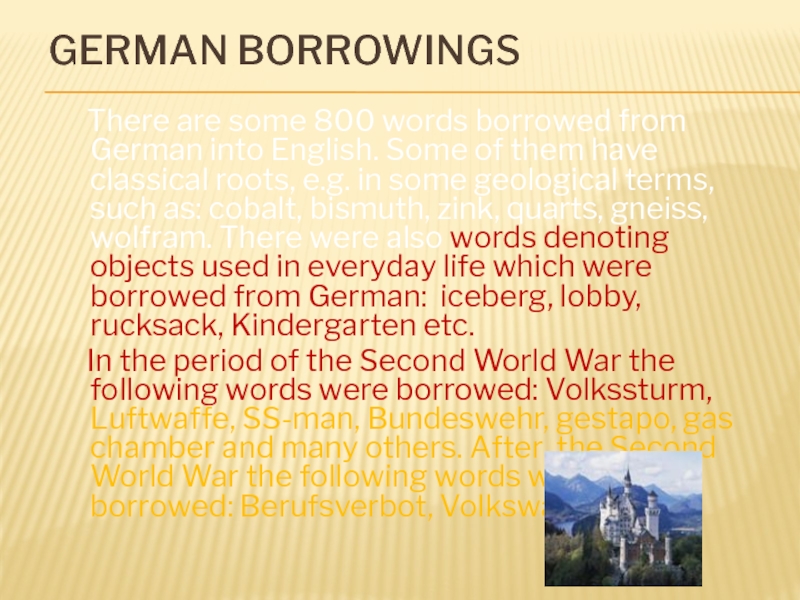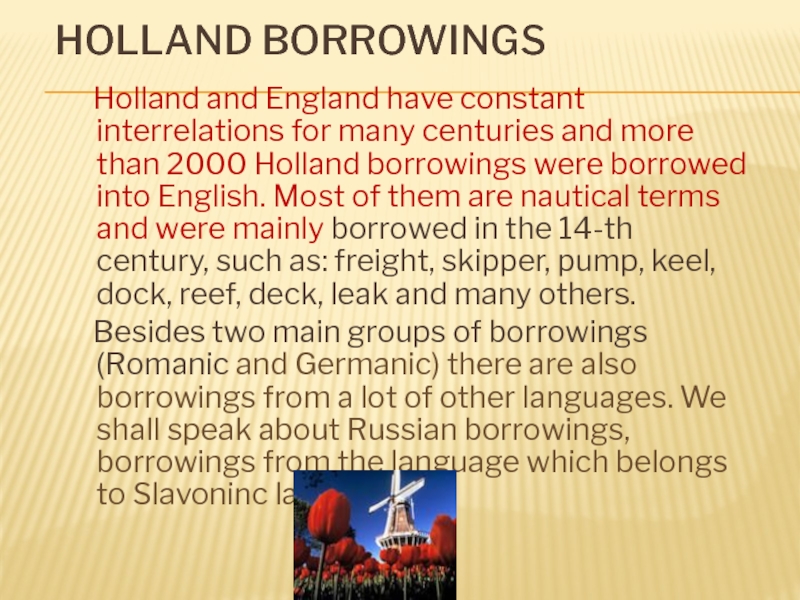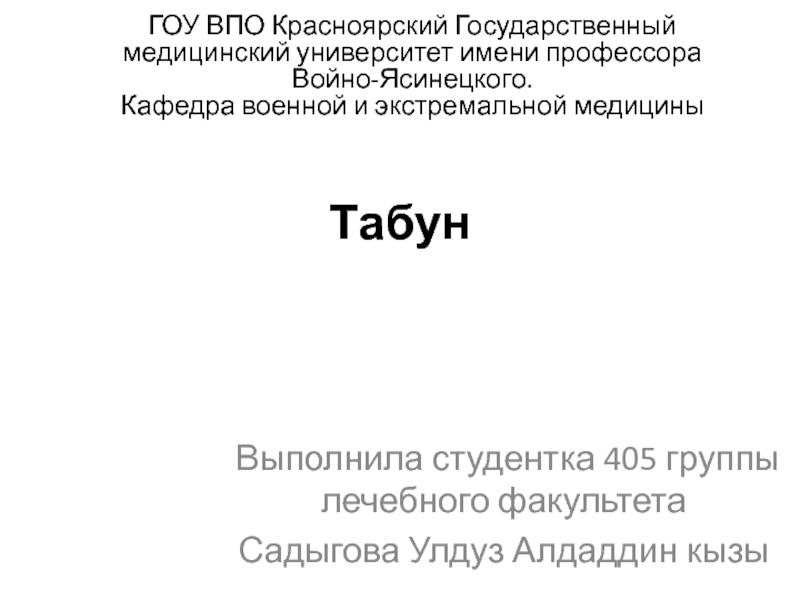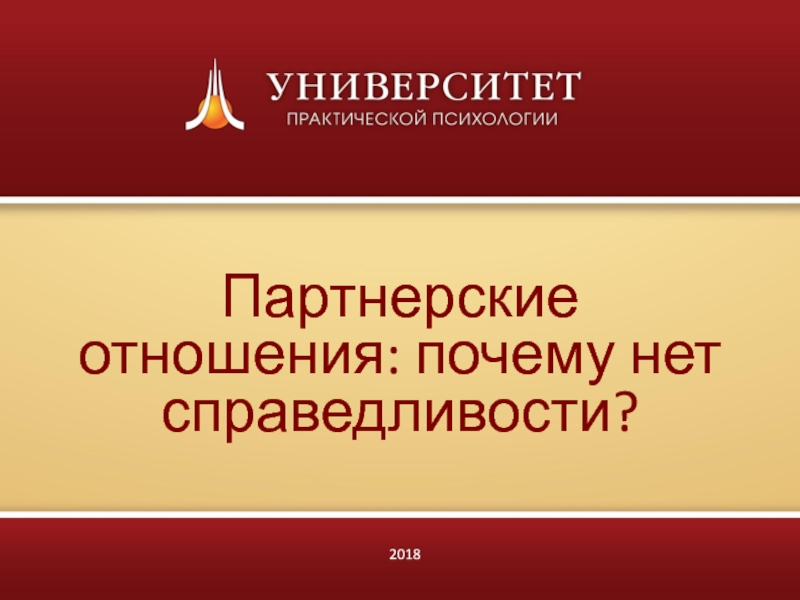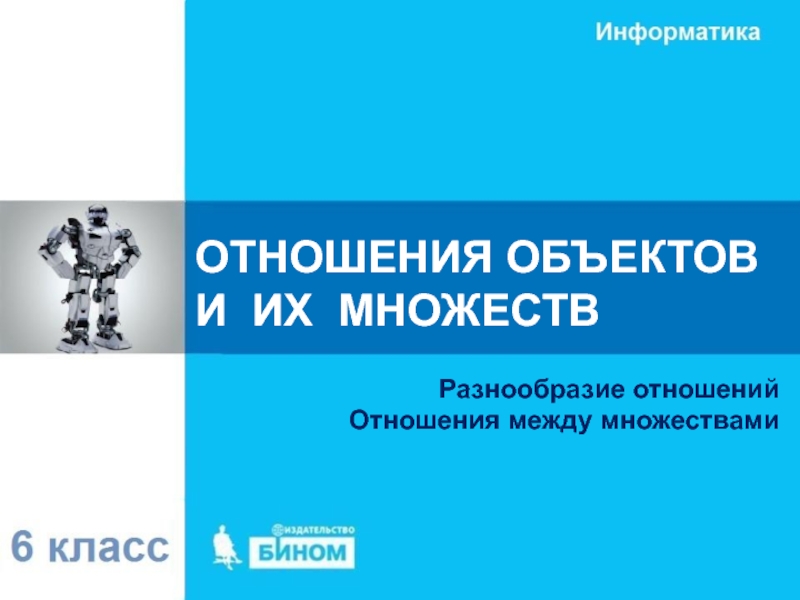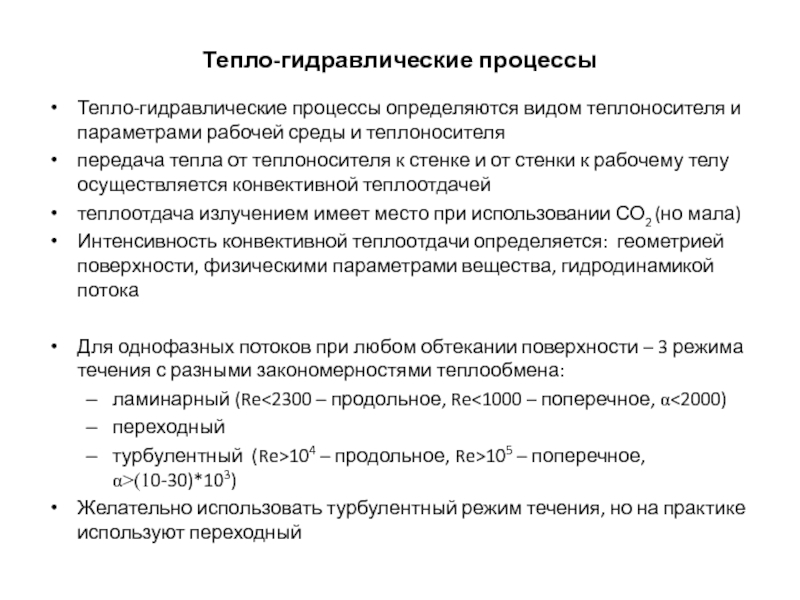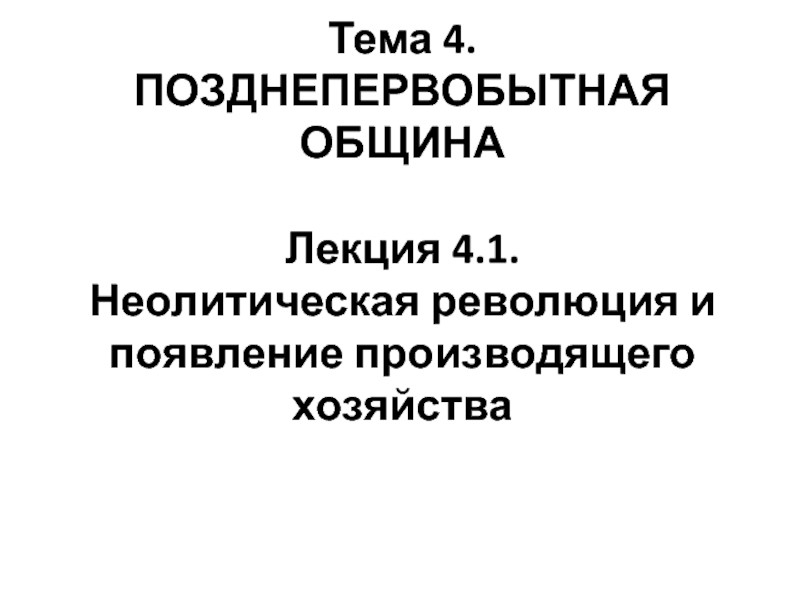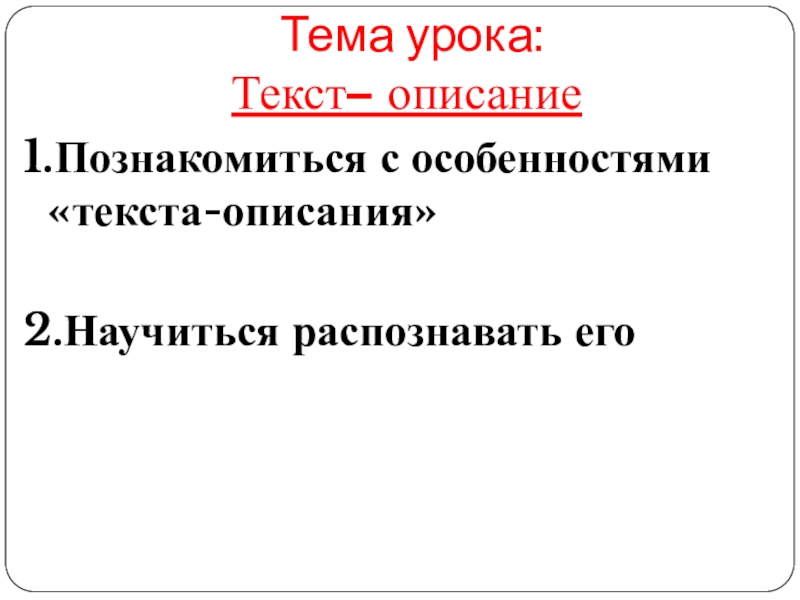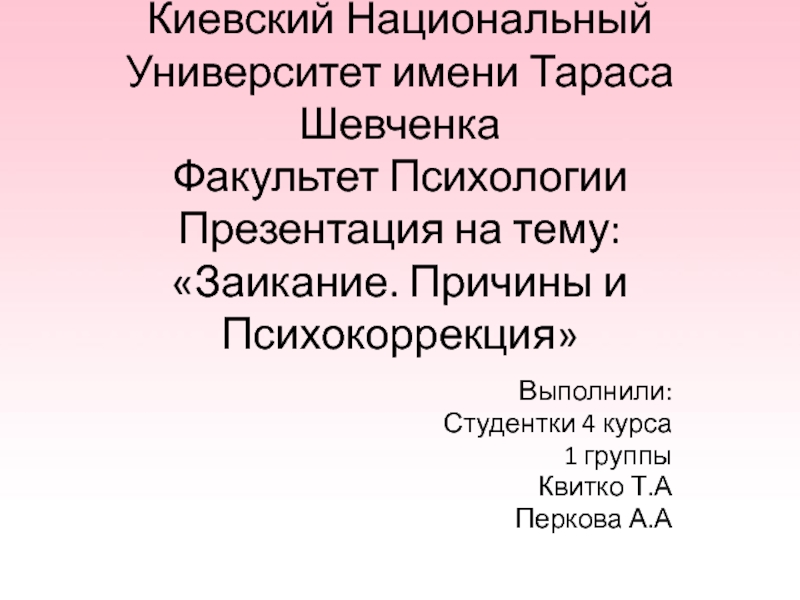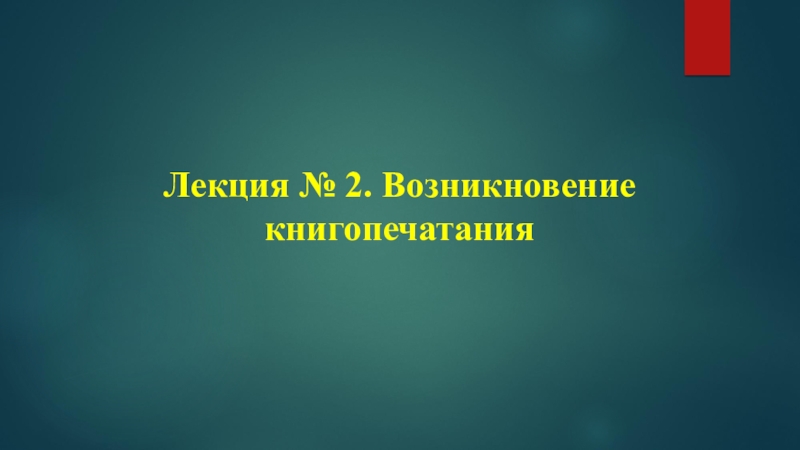Разделы презентаций
- Разное
- Английский язык
- Астрономия
- Алгебра
- Биология
- География
- Геометрия
- Детские презентации
- Информатика
- История
- Литература
- Математика
- Медицина
- Менеджмент
- Музыка
- МХК
- Немецкий язык
- ОБЖ
- Обществознание
- Окружающий мир
- Педагогика
- Русский язык
- Технология
- Физика
- Философия
- Химия
- Шаблоны, картинки для презентаций
- Экология
- Экономика
- Юриспруденция
Classification of borrowings in Modern English
Содержание
- 1. Classification of borrowings in Modern English
- 2. English history is very rich in different
- 3. Borrowing words from other languages is characteristic
- 4. Borrowings can be classified according
- 5. CLASSIFICATION OF BORROWINGS ACCORDING TO THE BORROWED
- 6. In some cases the spelling is
- 7. 2)Semantic borrowings are such units when a
- 8. Semantic borrowing can appear when an English
- 9. 3)Morphemic borrowings are borrowings of affixes which
- 10. CLASSIFICATION OF BORROWINGS ACCORDING TO THE DEGREE
- 11. Completely assimilated borrowings are not felt as
- 12. Semantic assimilation of borrowed words depends on
- 13. Partly assimilated borrowings are subdivided into the
- 14. c) borrowings non-assimilated phonetically. Here belong words
- 15. d) borrowings can be partly assimilated graphically,
- 16. Non-assimilated borrowings (barbarisms) are borrowings which
- 17. CLASSIFICATION OF BORROWINGS ACCORDING TO THE LANGUAGE
- 18. Latin and Greek borrowings
- 19. Classical borrowings continue to appear
- 20. French borrowingsThe largest group of borrowings are
- 21. Italian borrowings Cultural
- 22. Spanish borrowings Spanish borrowings came
- 23. GERMANIC BORROWINGS
- 24. Scandinavian borrowingsBy the end of the Old
- 25. German borrowings There are some
- 26. Holland borrowings Holland and England
- 27. Russian borrowings There were constant
- 28. Thank you for attention!
- 29. Скачать презентанцию
English history is very rich in different types of contacts with other countries, that is why it is very rich in borrowings. The Roman invasion, the adoption of Cristianity, Scandinavian and
Слайды и текст этой презентации
Слайд 3Borrowing words from other languages is characteristic of English throughout
its history. More than two thirds of the English vocabulary
are borrowings. Mostly they are words of Romanic origin (Latin, French, Italian, Spanish). Borrowed words are different from native ones by their phonetic structure, by their morphological structure and also by their grammatical forms. It is also characterisitic of borrowings to be non-motivated semantically.Слайд 4
Borrowings can be classified according to different criteria:
a) according to
the aspect which is borrowed,
b) according to the degree of
assimilation,c) according to the language from which the word was borrowed.
Слайд 5CLASSIFICATION OF BORROWINGS ACCORDING TO THE BORROWED ASPECT
1) Phonetic borrowings are most characteristic in all languages, they
are called loan words proper.Words are borrowed with their spelling, pronunciation and meaning.
Then they undergo assimilation, each sound in the borrowed word is substituted by the corresponding sound of the borrowing language.
Слайд 6 In some cases the spelling is changed.
The structure
of the word can also be changed.
The position of
the stress is very often influenced by the phonetic system of the borrowing language. The paradigm of the word, and sometimes the meaning of the borrowed word are also changed.
Such words as: labour, travel, table, chair, people are phonetic borrowings from French; apparatchik, nomenklatura, sputnik are phonetic borrowings from Russian; bank, soprano, duet are phonetic borrowings from Italian etc.
Слайд 72)Semantic borrowings are such units when a new meaning of
the unit existing in the language is borrowed.
It can
happen when we have two relative languages which have common words with different meanings: There are semantic borrowings between Scandinavian and English, such as the meaning «to live» for the word «to dwell» which in Old English had the meaning «to wander». Or the meaning «дар» , «подарок» for the word «gift» which in Old English had the meaning «выкуп за жену».
Слайд 8Semantic borrowing can appear when an English word was borrowed
into some other language, developed there a new meaning and
this new meaning was borrowed back into English:«Brigade» was borrowed into Russian and formed the meaning «a working collective«,»бригада». This meaning was borrowed back into English as a Russian borrowing. The same is true of the English word «pioneer».
Слайд 93)Morphemic borrowings are borrowings of affixes which occur in the
language when many words with identical affixes are borrowed from
one language into another, so that the morphemic structure of borrowed words becomes familiar to the people speaking the borrowing language.We can find a lot of Romanic affixes in the English word-building system, that is why there are a lot of words - hybrids in English where different morphemes have different origin - «goddess», «beautiful» etc.
Слайд 10CLASSIFICATION OF BORROWINGS ACCORDING TO THE DEGREE OF ASSIMILATION
The degree of assimilation of borrowings depends on
the following factors:from what group of languages the word was borrowed, if the word belongs to the same group of languages to which the borrowing language belongs it is assimilated easier,
in what way the word is borrowed: orally or in the written form, words borrowed orally are assimilated quicker,
how often the borrowing is used in the language, the greater the frequency of its usage, the quicker it is assimilated,
how long the word lives in the language, the longer it lives, the more assimilated it is.
Accordingly, borrowings are subdivided into:
completely assimilated
partly assimilated
non-assimilated (barbarisms).
Слайд 11Completely assimilated borrowings are not felt as foreign words in
the language, as the French word «sport» and the native
word «start».Completely assimilated verbs belong to regular verbs: correct -corrected.
Completely assimilated nouns form their plural by means of s-inflexion: gate- gates. In completely assimilated French words the stress has been shifted from the last syllable to the last but one.
Слайд 12Semantic assimilation of borrowed words depends on the words existing
in the borrowing language, as a rule, a borrowed word
does not bring all its meanings into the borrowing language, if it is polysemantic: the Russian borrowing «sputnik» is used in English only in one of its meanings.Слайд 13Partly assimilated borrowings are subdivided into the following groups:
a)
borrowings non-assimilated semantically, because they denote objects and notions peculiar
to the country from the language of which they were borrowed, e.g. sari, sombrero, taiga, kvass etc.b) borrowings non-assimilated grammatically, e.g. nouns borrowed from Latin and Greek retain their plural forms (bacillus - bacilli, phenomenon - phenomena, datum -data, genius - genii etc.
Слайд 14c) borrowings non-assimilated phonetically. Here belong words with the initial
sounds /v/ and /z/, e.g. voice, zero. In native words
these voiced consonants are used only in the intervocal position as allophones of sounds /f/ and /s/ ( loss - lose, life - live ).Some Scandinavian borrowings have consonants and combinations of consonants which were not palatalized, e.g. /sk/ in the words: sky, skate, ski etc (in native words we have the palatalized sounds denoted by the digraph «sh», e.g. shirt); sounds /k/ and /g/ before front vowels are not palatalized e.g. girl, get, give, kid, kill, kettle. In native words we have palatalization , e.g. German, child.
Слайд 15d) borrowings can be partly assimilated graphically, e.g. in Greek
borrowings «y» can be spelled in the middle of the
word (symbol, synonym), «ph» denotes the sound /f/ (phoneme, morpheme), «ch» denotes the sound /k/(chemistry, chaos),«ps» denotes the sound /s/ (psychology).Слайд 16 Non-assimilated borrowings (barbarisms) are borrowings which are used by
Englishmen rather seldom and are non-assimilated, e.g. addio (Italian), tete-a-tete
(French), dolce vita (Italian), duende (Spanish), an homme a femme (French), gonzo (Italian) etc.Слайд 17CLASSIFICATION OF BORROWINGS ACCORDING TO THE LANGUAGE FROM WHICH THEY
WERE BORROWED
ROMANIC BORROWINGS
Latin borrowings.
Among words of Romanic origin
borrowed from Latin during the period when the British Isles were a part of the Roman Empire, there are such words as: street, port, wall etc. Many Latin and Greek words came into English during the Adoption of Christianity in the 6-th century. At this time the Latin alphabet was borrowed which ousted the Runic alphabet. These borrowings are usually called classical borrowings. Here belong Latin words: alter, cross, dean, and Greek words: church, angel, devil, anthem.Слайд 18 Latin and Greek borrowings appeared in English
during the Middle English period due to the Great Revival
of Learning. These are mostly scientific words because Latin was the language of science at the time. These words were not used as frequently as the words of the Old English period, therefore some of them were partly assimilated grammatically, e.g. formula - formulae. Here also belong such words as: memorandum, minimum, maximum, veto etc.Слайд 19 Classical borrowings continue to appear in Modern English
as well. Mostly they are words formed with the help
of Latin and Greek morphemes. There are quite a lot of them in medicine (appendicitis, aspirin), in chemistry (acid, valency, alkali), in technique (engine, antenna, biplane, airdrome), in politics (socialism, militarism), names of sciences (zoology, physics) . In philology most of terms are of Greek origin (homonym, archaism, lexicography).Слайд 20French borrowings
The largest group of borrowings are French borrowings. Most
of them came into English during the Norman conquest. French
influenced not only the vocabulary of English but also its spelling, because documents were written by French scribes as the local population was mainly illiterate, and the ruling class was French. Runic letters remaining in English after the Latin alphabet was borrowed were substituted by Latin letters and combinations of letters, e.g. «v» was introduced for the voiced consonant /v/ instead of «f» in the intervocal position /lufian - love/, the digraph «ch» was introduced to denote the sound /ch/ instead of the letter «c» / chest/ before front vowels where it had been palatalized, the digraph «sh» was introduced instead of the combination «sc» to denote the sound /sh/ /ship/, the digraph «th» was introduced instead of the Runic letters «0» and « » /this, thing/.Borrowing of French words.
There are the following semantic groups of French borrowings:
a) words relating to government : administer, empire, state, government;
b) words relating to military affairs: army, war, banner, soldier, battle;
c) words relating to jury: advocate, petition, inquest, sentence, barrister;
d) words relating to fashion: luxury, coat, collar, lace, pleat, embroidery;
e) words relating to jewelry: topaz, emerald, ruby, pearl ;
f) words relating to food and cooking: lunch, dinner, appetite, to roast, to stew.
Words were borrowed from French into English after 1650, mainly through French literature, but they were not as numerous and many of them are not completely assimilated. There are the following semantic groups of these borrowings:
a) words relating to literature and music: belle-lettres, conservatorie, brochure, nuance, piruette, vaudeville;
b) words relating to military affairs: corps, echelon, fuselage, manouvre;
c) words relating to buildings and furniture: entresol, chateau, bureau;
d) words relating to food and cooking: ragout, cuisine.
Слайд 21 Italian borrowings
Cultural and trade relations
between Italy and England brought many Italian words into English.
The earliest Italian borrowing came into English in the 14-th century, it was the word «bank» /from the Italian «banko» - «bench»/. Italian money-lenders and money-changers sat in the streets on benches. When they suffered losses they turned over their benches, it was called «banco rotta» from which the English word «bankrupt» originated. In the 17-th century some geological terms were borrowed : volcano, granite, bronze, lava. At the same time some political terms were borrowed: manifesto, bulletin.But mostly Italian is famous by its influence in music and in all Indo-European languages musical terms were borrowed from Italian : alto, baritone, basso, tenor, falsetto, solo, duet, trio, quartet, quintet, opera, operette, libretto, piano, violin.
Among the 20-th century Italian borrowings we can mention : gazette, incognitto, autostrada, fiasco, fascist, diletante, grotesque, graffitto etc.
Слайд 22 Spanish borrowings
Spanish borrowings came into English mainly
through its American variant. There are the following semantic groups
of them:a) trade terms: cargo, embargo;
b) names of dances and musical instruments: tango, rumba, habanera, guitar;
c) names of vegetables and fruit: tomato, potato, tobbaco, cocoa, banana, ananas, apricot etc.
Слайд 23 GERMANIC BORROWINGS English belongs to the Germanic
group of languages and there are borrowings from Scandinavian, German
and Holland languages, though their number is much less than borrowings from Romanic languages.Слайд 24Scandinavian borrowings
By the end of the Old English period English
underwent a strong influence of Scandinavian due to the Scandinavian
conquest of the British Isles. Scandinavians belonged to the same group of peoples as Englishmen and their languages had much in common. As the result of this conquest there are about 700 borrowings from Scandinavian into English.Scandinavians and Englishmen had the same way of life,their cultural level was the same, they had much in common in their literature therefore there were many words in these languages which were almost identical, e.g.
ON OE Modern E
syster sweoster sister
fiscr fisc fish
felagi felawe fellow
However there were also many words in the two languages which were different, and some of them were borrowed into English , such nouns as: bull, cake, egg, kid, knife, skirt, window etc, such adjectives as: flat, ill, happy, low, odd, ugly, wrong, such verbs as : call, die, guess, get, give, scream and many others.
Even some pronouns and connective words were borrowed which happens very seldom, such as : same, both, till, fro, though, and pronominal forms with «th»: they, them, their.
Scandinavian influenced the development of phrasal verbs which did not exist in Old English, at the same time some prefixed verbs came out of usage, e.g. ofniman, beniman. Phrasal verbs are now highly productive in English /take off, give in etc.
Слайд 25German borrowings
There are some 800 words borrowed
from German into English. Some of them have classical roots,
e.g. in some geological terms, such as: cobalt, bismuth, zink, quarts, gneiss, wolfram. There were also words denoting objects used in everyday life which were borrowed from German: iceberg, lobby, rucksack, Kindergarten etc.In the period of the Second World War the following words were borrowed: Volkssturm, Luftwaffe, SS-man, Bundeswehr, gestapo, gas chamber and many others. After the Second World War the following words were borrowed: Berufsverbot, Volkswagen etc.
Слайд 26Holland borrowings
Holland and England have constant interrelations
for many centuries and more than 2000 Holland borrowings were
borrowed into English. Most of them are nautical terms and were mainly borrowed in the 14-th century, such as: freight, skipper, pump, keel, dock, reef, deck, leak and many others.Besides two main groups of borrowings (Romanic and Germanic) there are also borrowings from a lot of other languages. We shall speak about Russian borrowings, borrowings from the language which belongs to Slavoninc languages.
Слайд 27Russian borrowings
There were constant contacts between England
and Russia and they borrowed words from one language into
the other. Among early Russian borrowings there are mainly words connected with trade relations, such as: rouble, copeck, pood, sterlet, vodka, sable, and also words relating to nature, such as: taiga, tundra, steppe etc.There is also a large group of Russian borrowings which came into English through Rushian literature of the 19-th century, such as : Narodnik, moujik, duma, zemstvo. volost, ukase etc, and also words which were formed in Russian with Latin roots, such as: nihilist, intelligenzia, Decembrist etc.
After the Great October Revolution many new words appeared in Russian connected with the new political system, new culture, and many of them were borrowed into English, such as: collectivization. udarnik, Komsomol etc and also translation loans, such as: shock worker, collective farm, five-year plan etc.
One more group of Russian borrowings is connected with perestroika, such as: glasnost, nomenklatura, apparatchik etc.
